Inside the bubble: exploring the environments of reionisation-era Lyman-α emitting galaxies with JADES and FRESCO⋆
Astronomy & Astrophysics EDP Sciences 682 (2024) a40
JADES: Resolving the Stellar Component and Filamentary Overdense Environment of Hubble Space Telescope (HST)-dark Submillimeter Galaxy HDF850.1 at z = 5.18
The Astrophysical Journal American Astronomical Society 961:1 (2024) 69
Nebular emission from young stellar populations including binary stars
Monthly Notices of the Royal Astronomical Society Oxford University Press (OUP) 527:3 (2023) 9480-9504
beagle-agn I: simultaneous constraints on the properties of gas in star-forming and AGN narrow-line regions in galaxies
Monthly Notices of the Royal Astronomical Society Oxford University Press (OUP) 527:3 (2023) 7217-7241
JADES Initial Data Release for the Hubble Ultra Deep Field: Revealing the Faint Infrared Sky with Deep JWST NIRCam Imaging
The Astrophysical Journal Supplement Series American Astronomical Society 269:1 (2023) 16


